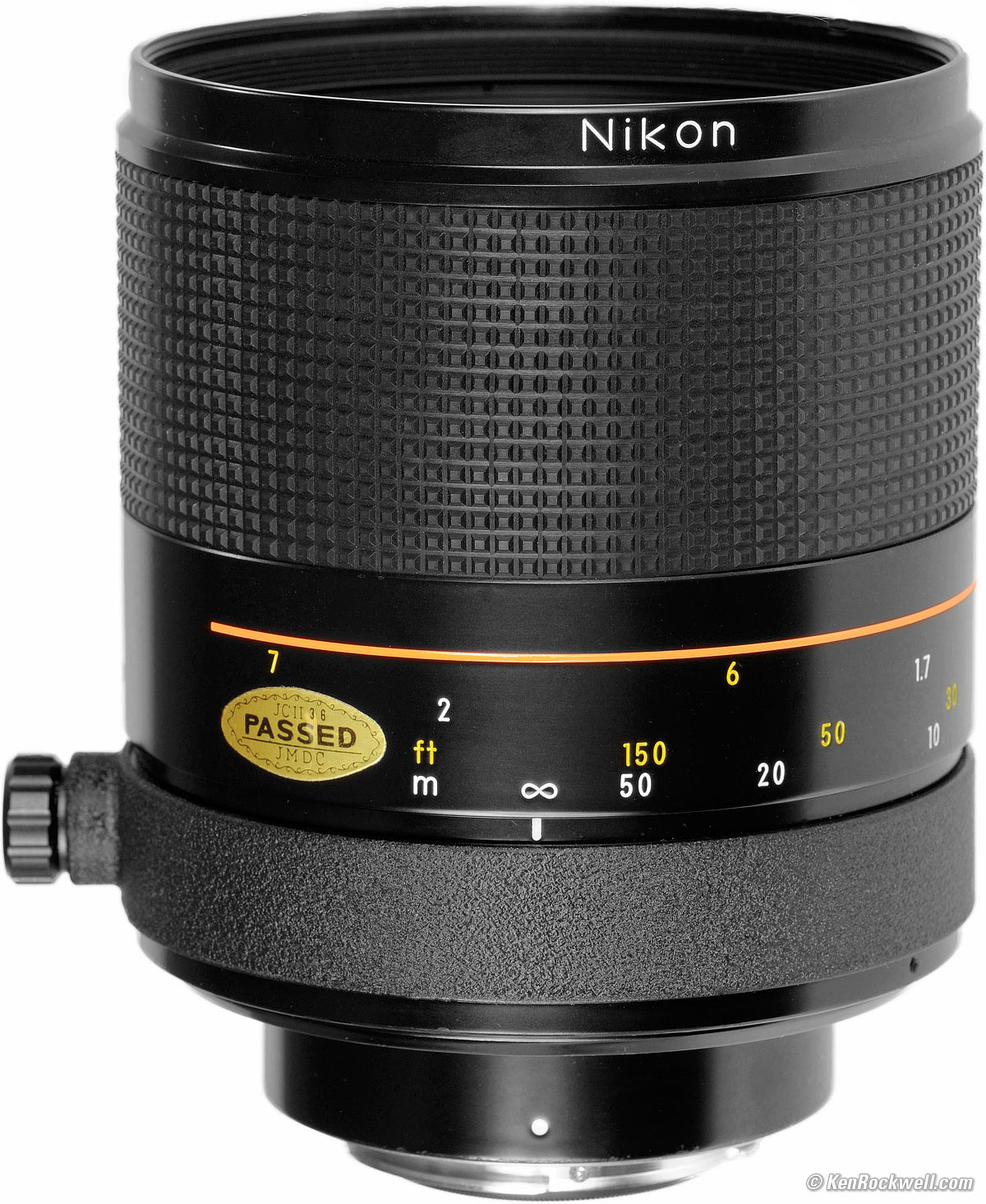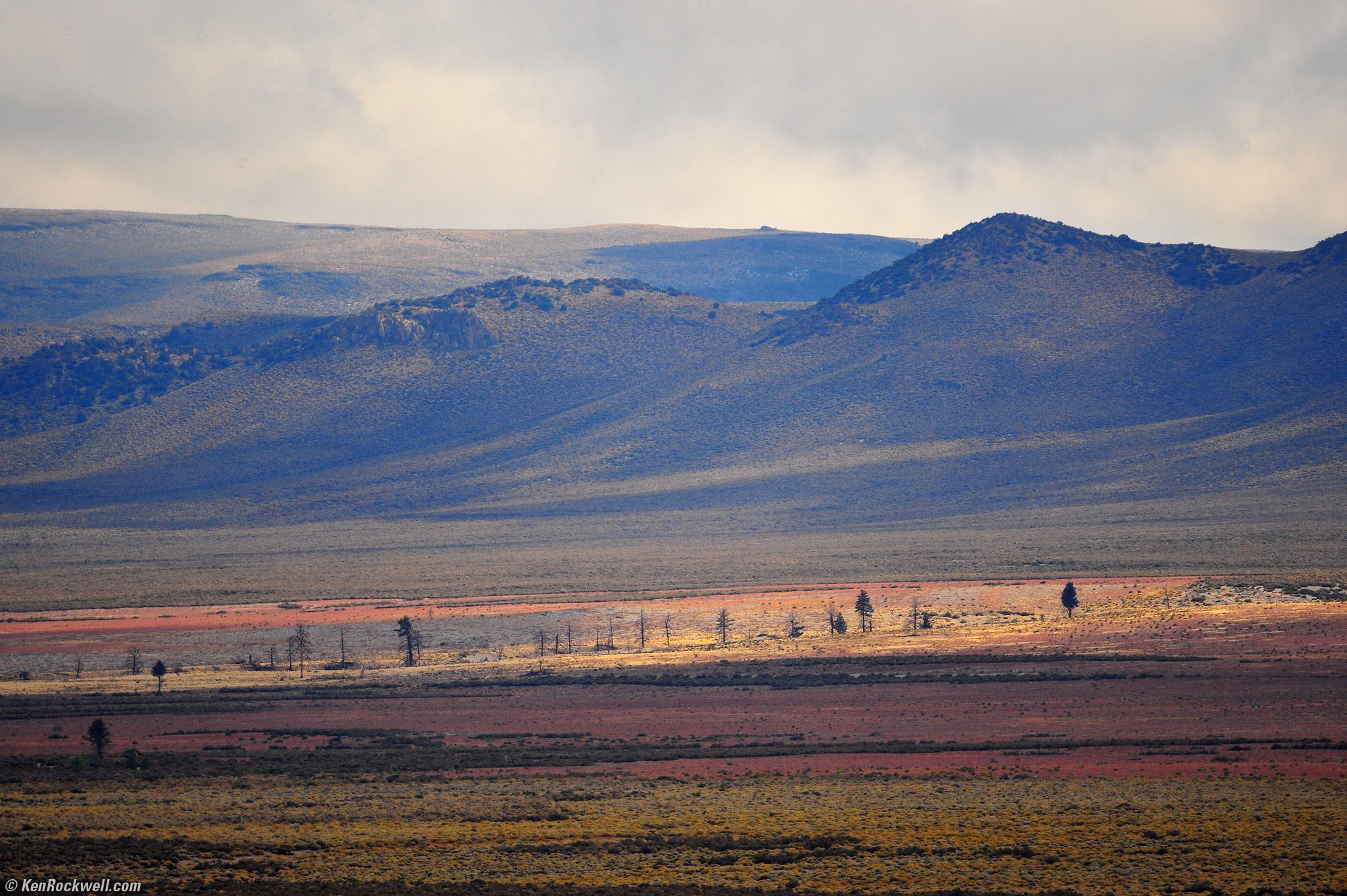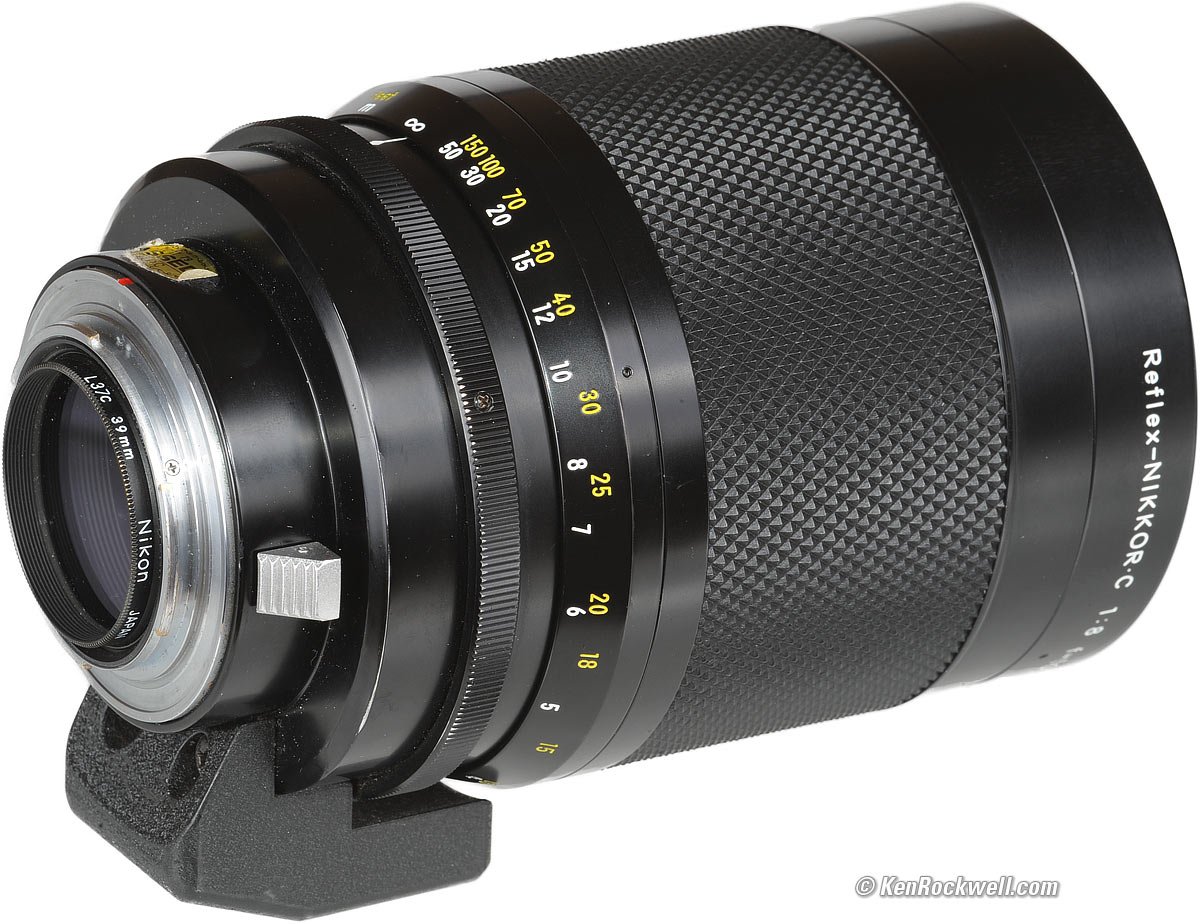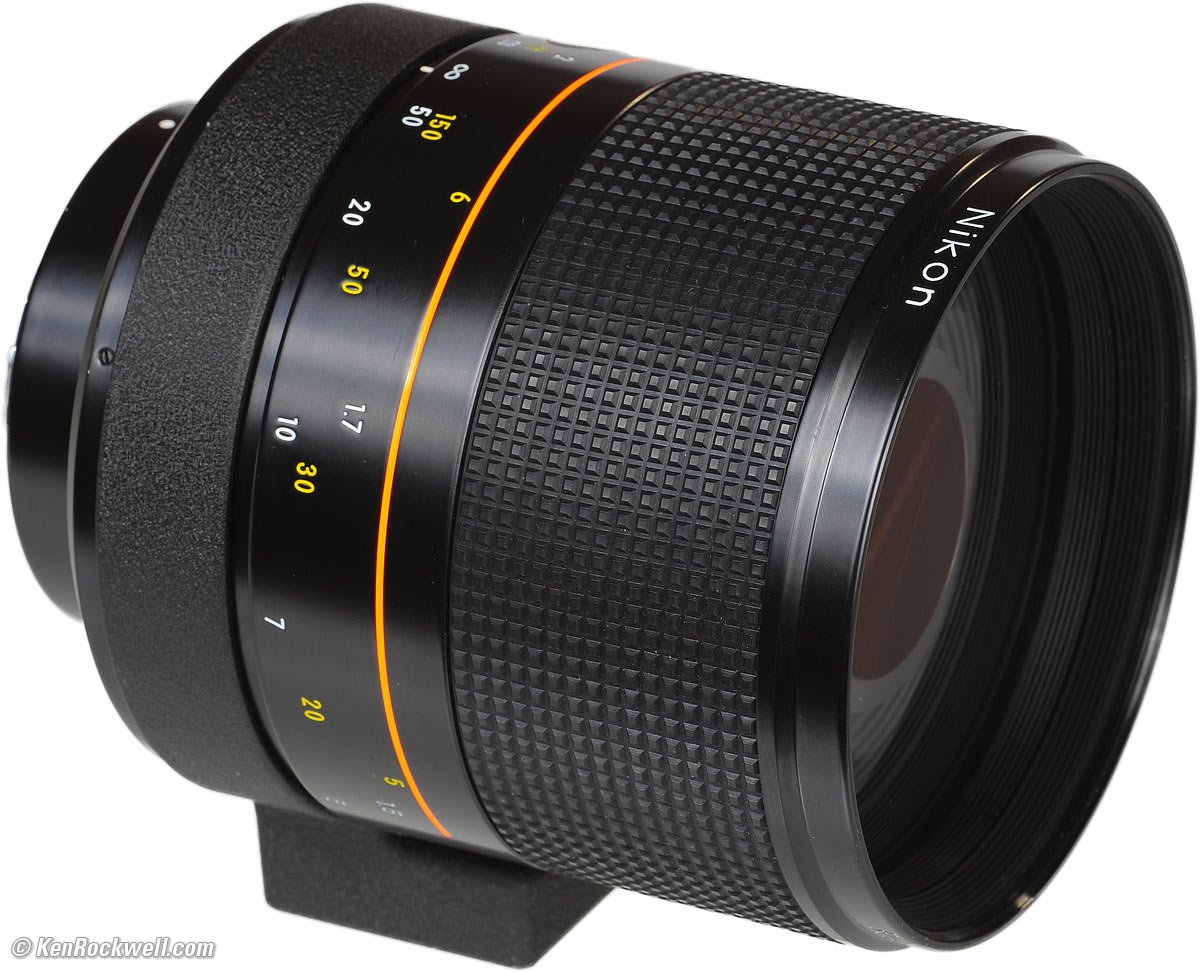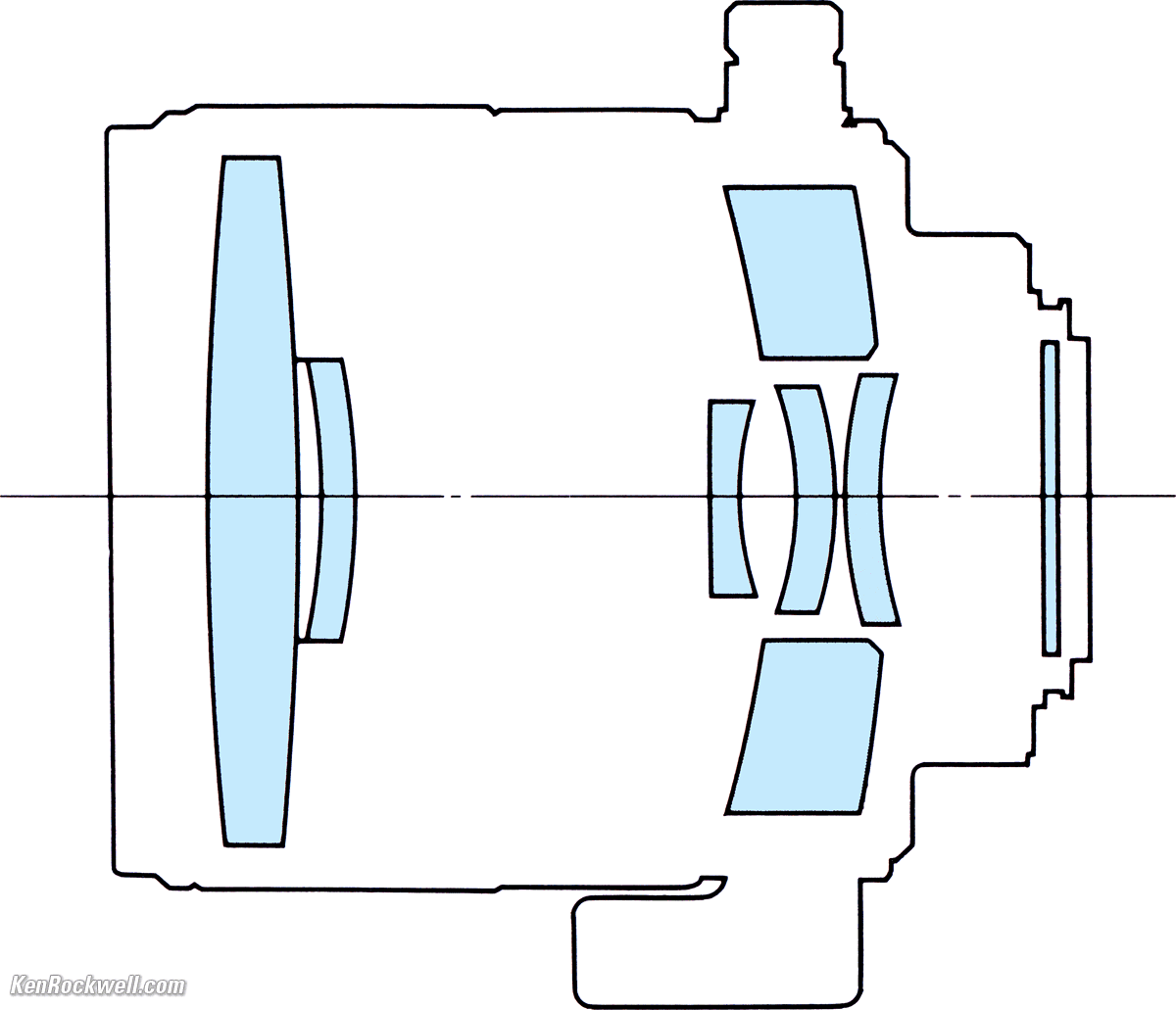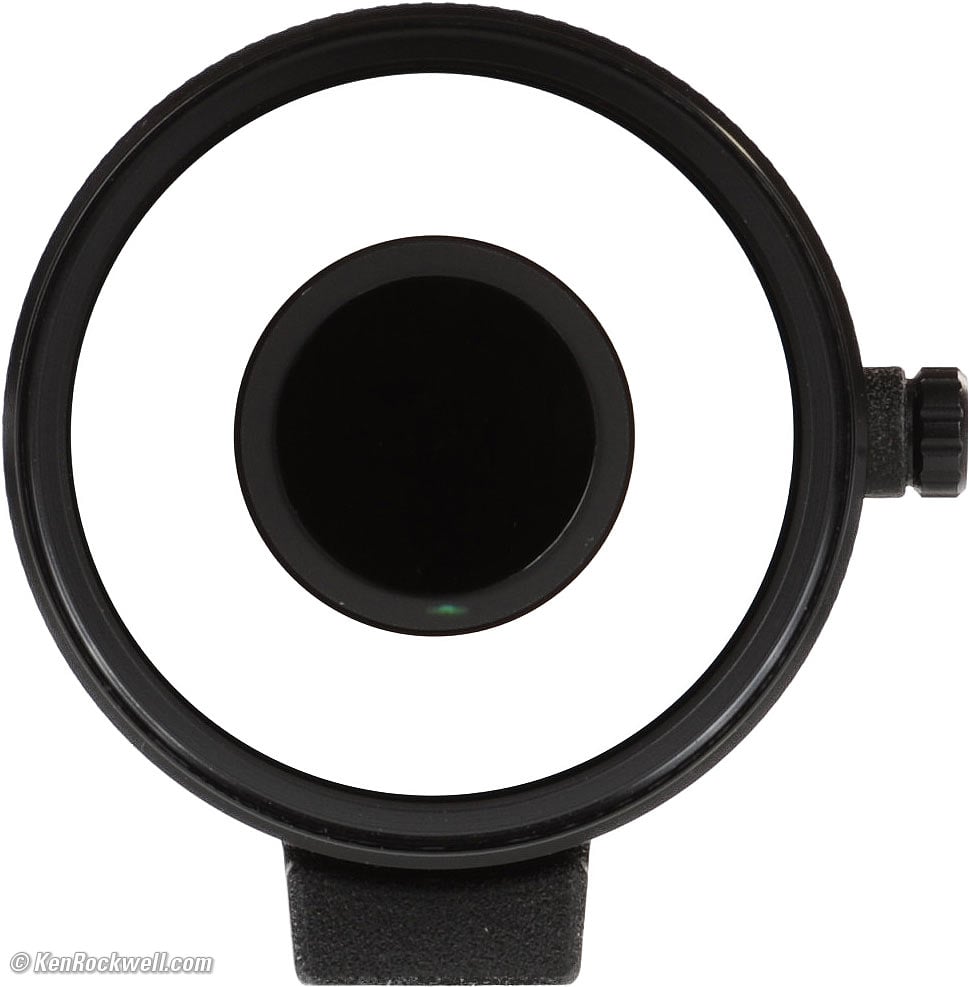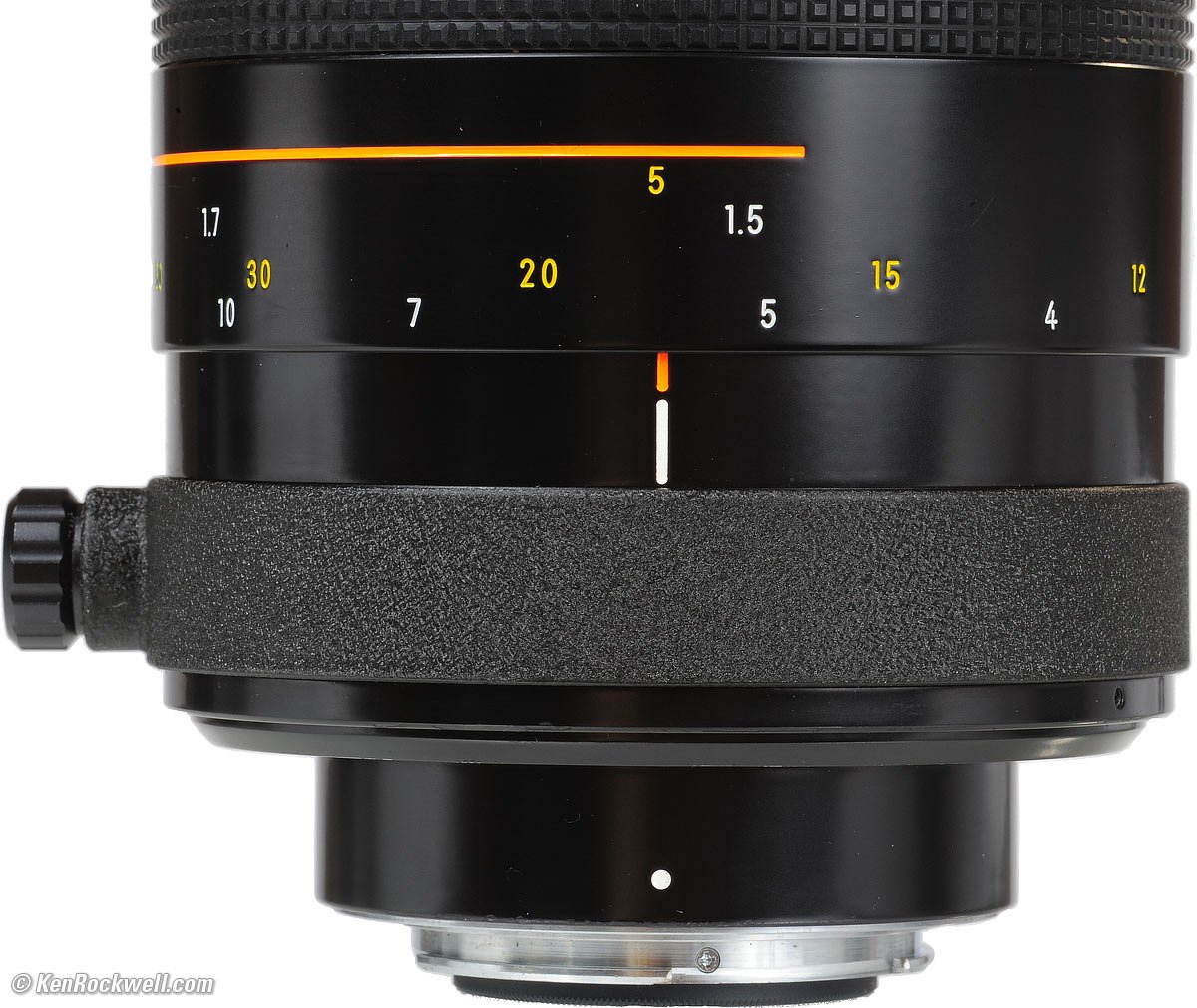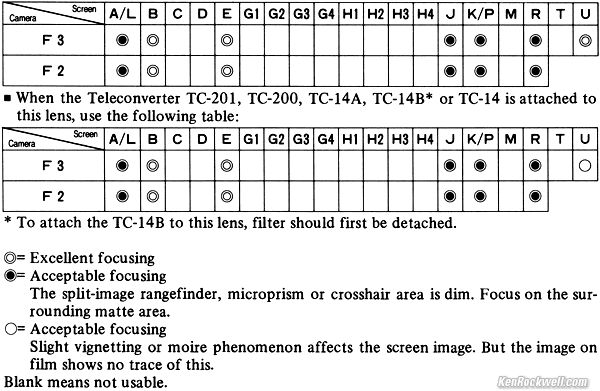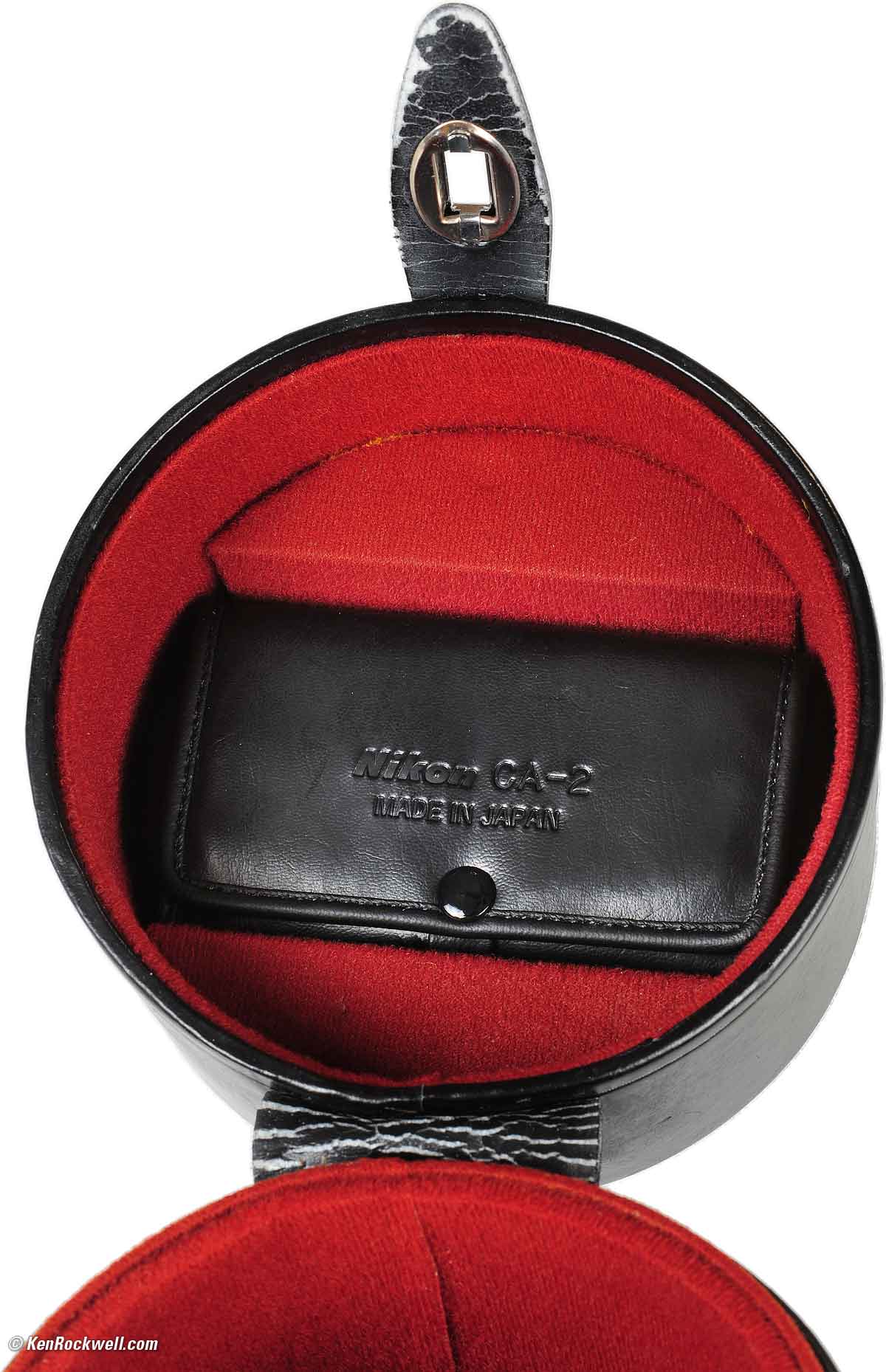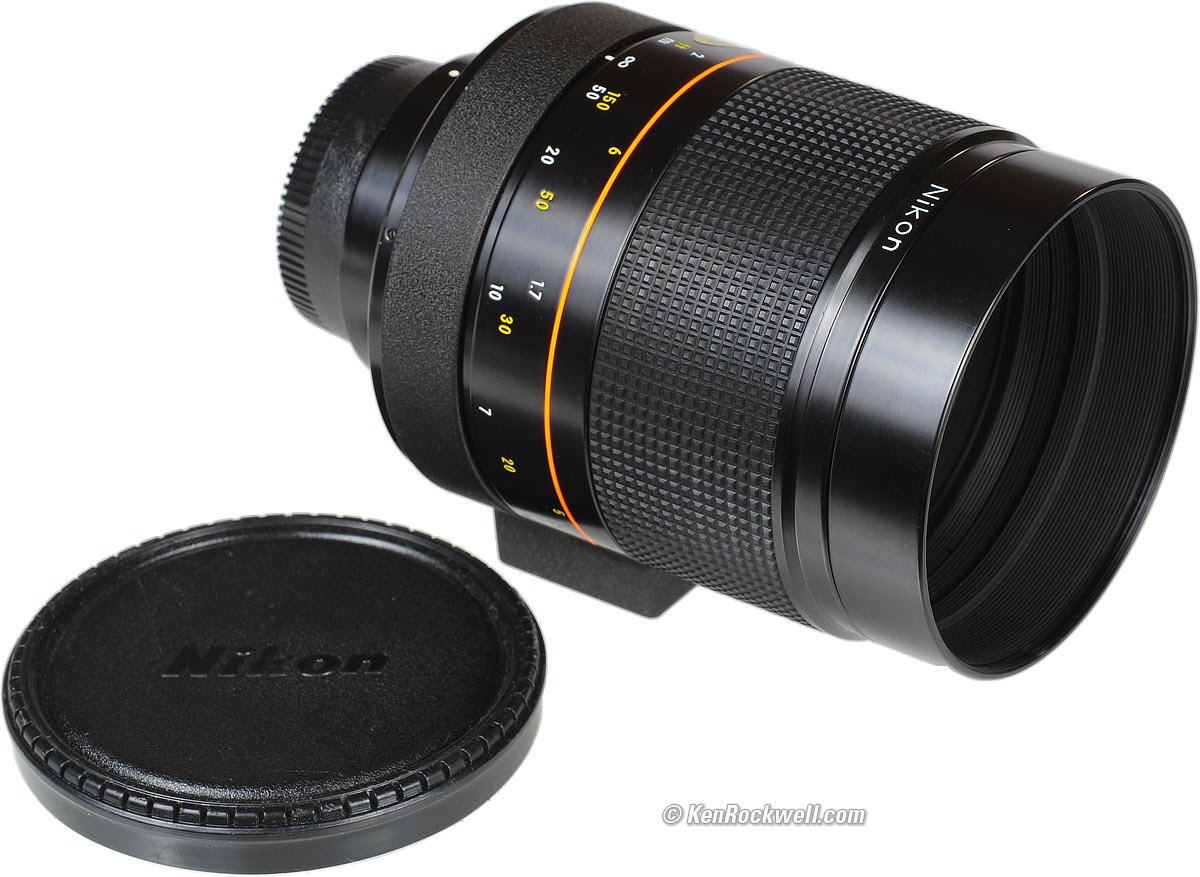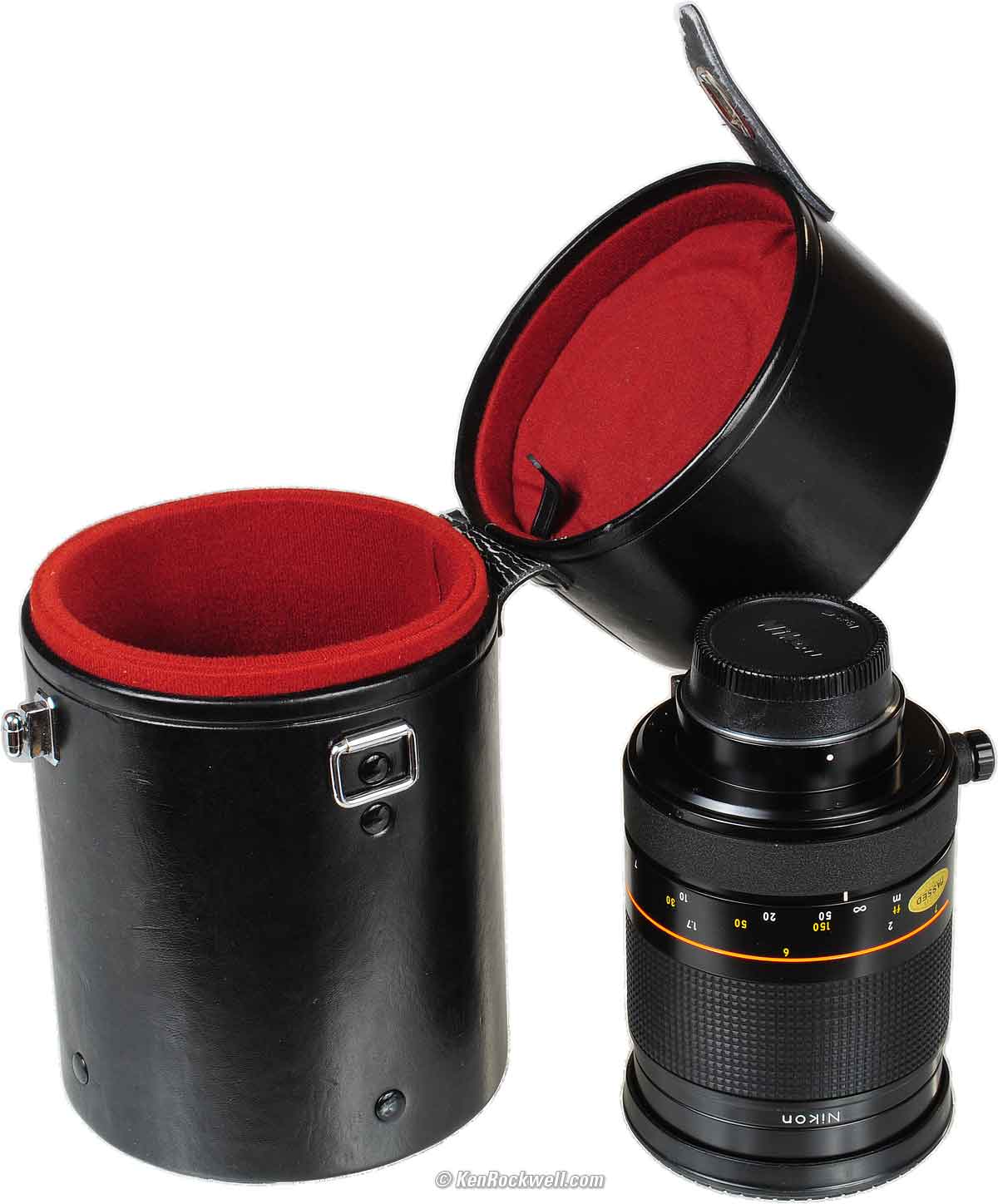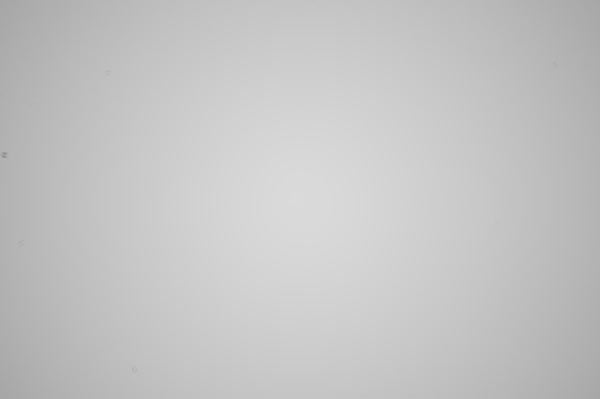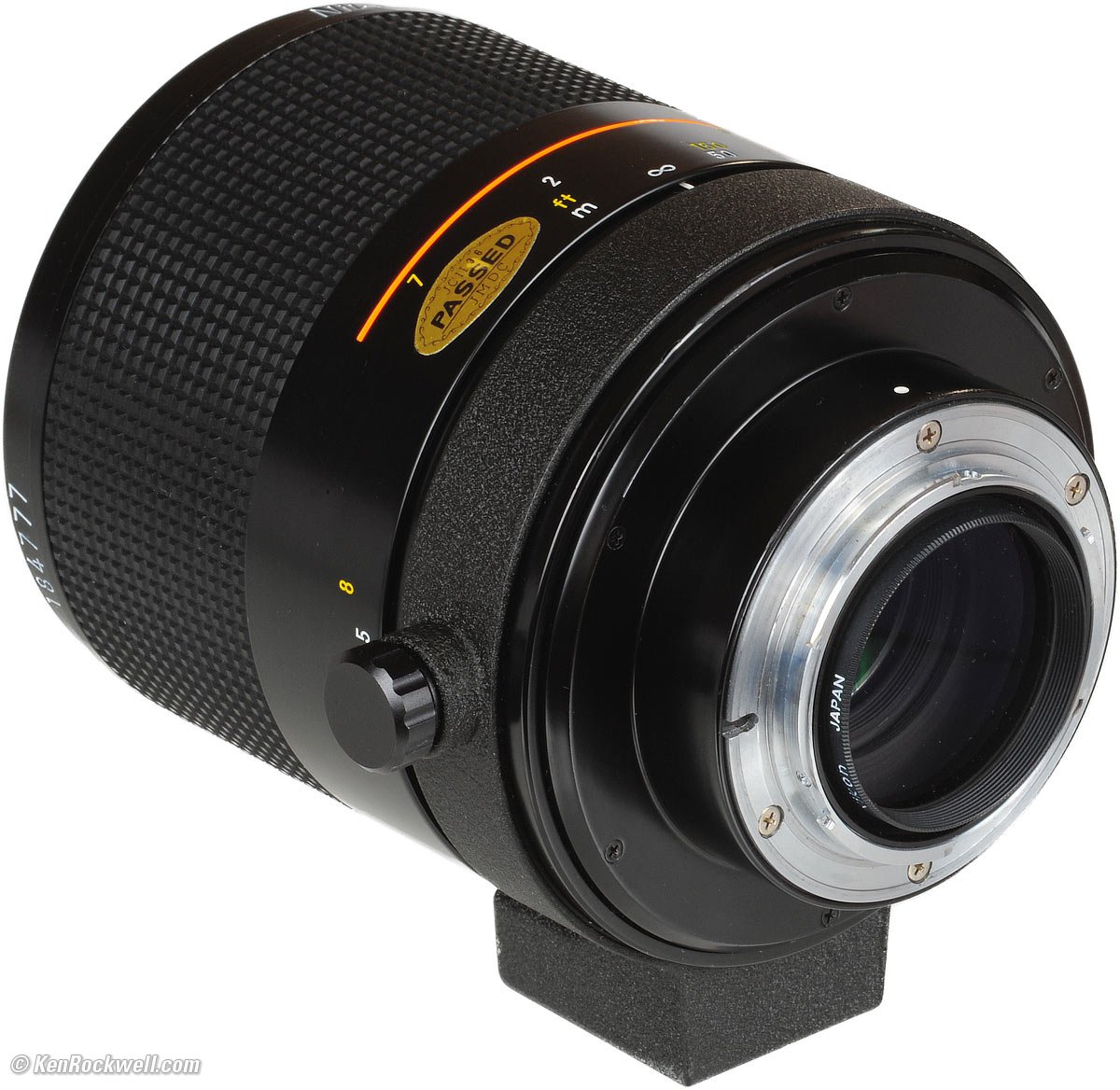Home Donate New Search Gallery How-To Books Links Workshops About Contact
Nikon 500mm f/8
Reflex-NIKKOR (1983-2005)
Intro Specifications Performance Recommendations
Nikon 500mm f/8 N Reflex-NIKKOR (39mm rear and 82mm front filters, 29.030 oz./823.0g with hood and filter, about $300 used if you know How to Win at eBay). enlarge.
This all-content, junk-free website's biggest source of support is when you use those or any of these links to approved sources when you get anything, regardless of the country in which you live. Thanks for helping me help you! Ken.
July 2021 More Nikon Reviews Nikon Lens Reviews
Older model Nikon 500mm f/8 C review
Sample Image top
More samples throughout this review.
These are just snapshots; my real work is in my Gallery.
Shot hand-held as BASIC ★ JPG; no tripods, NORMAL or FINE JPGs or RAW files were used or needed:
Mono Lake, 05 October 2010. bigger.
Snapped with a Nikon D3 and Nikon Reflex-NIKKOR 500mm f/8 N at 1/2,000 at ISO 800, hand-held.
Don't let the light fool you; the whole point of this snap is that a beam of sunlight is coming through a hole in the clouds to light the stand of trees.
Great for
Super-high magnification and ultra-close focusing in a tiny package.
The one best photographic use of this may be trying to sneak a very long lens into places you shouldn't, and with digital's great-looking stupid-high ISO's, this lens works better today that it ever could on film.
Superb for use with the Nikon Lens Scope Converter.
Not for
A poor choice for photography. The Nikon 500/8 Reflex has superb optics, but the ultra-high magnification also magnifies even the most microscopic camera movement. It is nearly impossible to get sharp images, either hand-held or on a tripod, since its tiny size and weight does nothing to damp vibration. It's also very difficult to focus perfectly, since the finder image is dim.
| Optics: | |
| Ergonomics: | |
| Usefulness: | |
| Availability: | |
| Overall: |
Introduction top
Intro Specifications Performance Recommendations
|
|
The Nikon 500mm f/8 Reflex-NIKKOR is optically superb, however it is nearly impossible to make sharp images with it. It is best used as a telescope with the Nikon Lens Scope Converter.
It has ten times the magnification of a standard lens, but doesn't weigh much more than a standard lens.
Therefore it magnifies camera shake by ten times, but since its tiny size does nothing to help dampen these vibrations, one must shoot at about 1/2,000 of a second or faster for best results, hand-held.
It doesn't work well on a tripod either, because even the slightest camera vibration is also magnified, even with mirror lock-up.
It's best to shoot at ISO 800 or higher in daylight to get fast enough shutter speeds.
I get the best results hand-held, since my flesh dampens camera vibration better than a boingy tripod.
For more fixed use, a beanbag seems like a great idea.
This is a manual focus lens. Even if you can shoot fast enough to quell vibration, good luck getting it in focus.
Every 500mm lens has paper-thin depth-of-field. Since reflex lenses have no diaphragms, there is no way to stop-down this lens to hide focus errors. You must focus at a dim f/8, and hope you got it perfect, since even the tiniest focus error will dull your images.
Forget it with manual-focus cameras. The central split-image turns black, and the microprisms are almost useless as well, so you're on your own trying to focus on dim ground glass.
The best cameras with which to use this are the better autofocus and digital cameras with three-dot electronic manual focus indicators.
Even if you do use this on a top camera like the D3 or F6 with three-step electronic manual focus indicators, you'll discover that the focus ring, even though it turns a full 420º (more than a full turn), still turns too fast to allow us to focus precisely.
Even though no Nikon AF or digital cameras are rated as having electronic focus indicators that work with lenses of slower than f/5.6, the odd optics of this lens actually work just fine with the three-dot electronic indicators.
Another reason so many people buy these lenses, and then sell them, is because out-of-focus highlights become very distracting and unnatural donuts, not simply circles.
If you can get past the fact that it's very difficult to make a good picture with this lens, it sells for bargain prices, and is extraordinarily well made. It works best used as a telescope or conversation piece than for photography.
The manual-focus Nikon 500mm f/8 Reflex-NIKKOR is compatible with most Nikon cameras, 35mm and digital.
It works with every manual focus Nikon ever made, from the F of 1959 through the FM3a and today's FM-10.
On the D3X, D3s, D3, D700, D300, D200, D2 and F6, use the "Non-CPU Lens Data" menu option to set 500mm and f/8 to get full color matrix metering, EXIF data and finder read-out of set aperture. It works great in aperture-preferred as well as manual modes on these cameras.
It works on every professional 35mm camera (F, F2, F3, F4, F5, F6).
The meters of cheaper digital (D90, D5000 and below) and cheaper film cameras (N80 and below) will not couple (or work at all) with this lens, so you'll be on your own guessing exposure using the rear LCD or an external meter, or get a tiny Gossen Digisix meter and hot shoe adapter to meter manually.
See Nikon Lens Compatibility for details on your camera. Read down the "AI-converted" column for this lens.
1961-1968
Nikon's first 500mm reflex lens is the much larger and faster 50cm (500mm) f/5.
It's a beast, and focuses with a conventional helicoid at the very rear, which moves the camera body in and out. It only focuses as close as 50 feet (15 meters) and uses 39mm rear screw-in filters.
Oddly, due to the central obstruction of reflex lenses, this faster old lens does not work with the electronic focus indicators of AF and digital SLRs.
This lens is more of a collectors item today, selling used for about $600 in 2010. Nikon only made about 2,500 of them.
1968-1983
Earlier Nikon 500mm f/8. enlarge.
Nikon's first f/8 500mm lens is much smaller than the earlier f/5, but still much larger than this most recent lens. It focuses to 4 meters (13 feet) and uses both 88mm front and 39mm rear filters.
This older reflex lens sells used for less (about $300 in 2010) than this newest lens because its so much bigger and less convenient.
It was single-coated from 1968-1974, and multicoated from 1974-1983. The multicoated version adds a "C" to the model name.
These are found all over the place. Nikon made about 70,000 of them. When you look for used 500mm lenses, this is what you'll usually find.
1983-2005
This newest reflex lens is both much smaller, and much closer focusing than all its predecessors. This is why this lens sells for so much more than the earlier f/8 version.
Nikon made about 30,000 of these.
Often this newest version is called the f/8 N, for New, or sometimes the "AI-s" version (of course it isn't AI-s since is has no diaphragm).
If you're shopping online for these, the most obvious way to determine what version is for sale is to notice the brilliant orange "macro" line that runs around the focus ring. Earlier versions didn't focus very close, and have no such orange line.
Nikon 500mm f/8 N Reflex-NIKKOR. enlarge.
Specifications top
Intro Specifications Performance Recommendations
Name
Nikon calls this the Nikon Reflex-NIKKOR 500mm f/8.
Others add an "N" to differentiate this newer 1983-2005 lens from the 1968-1983 version.
Optics top
Nikon 500mm f/8 Reflex-NIKKOR. enlarge.
Catadioptric design: it uses mirrors as do the world's largest astronomical telescopes!
An advantage of this deign is freedom from chromatic aberration; there simply isn't any.
Nikon says 6 elements in 6 groups. Four are refractive glass, two are mirrors, and a seventh is the flat filter at the rear.
It's multicoated, which Nikon calls Nikon Integrated Coating (NIC).
Diaphragm top
Front view, Nikon 500mm f/8 Reflex-NIKKOR. enlarge.
No diaphragm.
Always at f/8.
If you don't like it, an ND 4x (two-stop) filter is included, but I don't know that anyone has ever bothered with it.
Clear aperture: 75mm.
Central obstruction diameter: 40mm.
Effective Aperture: 63.4mm, or f/7.9.
Thus it really ought to be called T8, since it's really more like f/6.7 with an obstruction at f/12.5.
Rear view, Nikon 500mm f/8 Reflex-NIKKOR. enlarge.
Aperture Ring top
None (no diaphragm).
Close Focus top
5 feet.
1.5 meters.
Maximum Reproduction Ratio top
1:2.5.
Angle of View top
5° on FX and 35mm.
Focal Length top
500mm.
On a small-format DX camera, this lens sees an angle-of-view similar to what a 750mm lens would see on a full-frame camera.
Hard Infinity Focus Stop? top
No.
Nikon lets it focus past infinity so that we'll always be able to focus properly, even at extreme temperatures.
Focus Scale top
Nikon 500mm f/8 N Focus Scale. bigger.
Yes.
It turns more than 360º around, just like that kid's head in Poltergeist! If unwrapped, the scale is over 15" (39cm) long!
Since it turns a full 420,º Nikon very cleverly uses a two-color index that turns orange when you should be looking at the orange part of the scale, the macro range.
Focus Screens top
Because this lens is so horribly slow, Nikon made some special focus screens to try to deal with it.
The standard screen in most manual-focus cameras is the K screen, with split-image and microprism. The problem is that these turn black with a lens this slow.
For the FA, FE, FE-2 and FM2, use the F3 column, and read K, B and E as K2, B2 and E2 as needed.
Nikon 500mm f/8 N Suggested Focus Screens.
Not shown in this 1983 vintage table is that Nikon introduced an "F" screen especially for slow reflex lenses for use with the F4. The F screen only exists for the F4, never having been made for other cameras. The F screen uses different optics optimized for the different position of the reflex lens' rear nodal point. Here is the table for all lenses and screens with the F4.
With the F4 and F5, it is still most precise to focus with the electronic indicators.
The F screen really is clearer and brighter with this lens in the F4, but I don't know that it works better enough to make me want to pull my screen and prism and screw with getting all this dirty in the field when I change a lens. I'd only do this if I dedicated an F4 body to a reflex lens.
Depth-of-Field Scale top
No, because there is no depth of field!
Infra-Red Focus Index top
No, but not needed.
With this reflex lens, infra-red focuses in the same place.
Filter Threads top
Front: 82mm (p=0.75mm), metal.
Rotates with focus.
Rear: Nikon's 39mm screw-in, metal.
Does not rotate.
Filters top
CA-2 filter case, hidden under red flap. enlarge.
Comes with a complete set of five filters.
The L37c (clear) filter comes mounted on the back of the lens.
There is a CA-2 filter case hidden in the top of the lens case with four more filters: O56 (orange) for black-and-white film, A2 (amber) and B2 (blue) for slightly altering color balance, and ND 4x, to give the equivalent of T16 for no good reason.
Use the L37c with digital cameras.
Use the A2 outside with color slide film.
The newer NC (no color) 39mm filter is Nikon part number 2478 NASI, and Nikon also made filters of other colors, like Y48, R60 and A12, in 39mm.
Tripod Collar top
Yes.
Does not come off.
Rotates, has clicks at all four 90º points, and has a friction screw lock.
Size top
Nikon specifies 116mm long overall by 89mm diameter.
Weight top
29.030 oz./823.0g with HN-27 ring hood and mandatory rear filter.
28.098 oz. (796.5g) without hood.
HN-27 ring hood alone: 0.930 oz. (26.45g).
Nikon specifies 29.6 oz. (840g).
Hood top
Nikon HN-27 Hood. enlarge.
HN-27 metal screw-in, included.
This hood is always left on. All it is is an 18.025mm-long filter ring extension tube.
Caps top
It uses a standard LF-1 rear cap, and an 85mm push-on soft plastic front cap.
Nikon 500/8, HN-27 and caps. enlarge.
Case top
Nikon CL-39 case, 500/8, HN-27 and caps. enlarge.
CL-39 case, included.
Made in top
Japan.
Teleconverters top
TC-200, TC-201 (may vignette), TC-14, TC-14A (may vignette) and TC-14B (remove rear filter).
Price, U. S. A. specifications top
June 2022
About $300 used if you know How to Win at eBay.
October 2010
About $500 used if you know How to Win at eBay.
Performance top
Intro Specifications Performance Recommendations
Overall Focus Bokeh Color Distortion Ergonomics Falloff Filters
Color Fringes Mechanics Sharpness Sunstars Tripod Collar
Overall performance top
The 500mm f/8 Reflex-NIKKOR is optically superb (except for its demonic bokeh), but very difficult to use for photography.
Focus performance top
Manual focus is as smooth as silk and has no play. It flicks around as if it's floating on air, but with no play.
Even though it turns so far, with its tiny depth of field, it is still geared too slow. It takes a very steady and precise hand to set the focus precisely.
The D3, D3X, D3s, D700, F4, F5, F6 and most professional AF cameras have three very precise electronic manual focus indicators, with which this lens works perfectly.
Lesser digital cameras, like the D300s and down, usually have just one "OK" focus dot, which is not as precise as two arrows and a dot.
Bokeh performance top
Sample photo at 30 meters. enlarge.
Bokeh, the character of out-of-focus backgrounds, not simply how far out of focus they are, is hideous.
Because of the central obstruction, out-of-focus circles become donuts.
This cannot be overlooked, since with a 500mm lens, there are almost always out-of-focus highlights that do this.
Color Rendition performance top
The color rendition of this Nikon 500mm f/8 seems to match my other lenses.
Distortion performance top
The Nikon 500mm f/8 has no visible distortion at any distance.
For scientific use, its very minor pincushion distortion can be corrected by plugging these figures into Photoshop's lens distortion filter. These aren't facts or specifications, they are the results of my research that requires hours of photography and calculations on the resulting data.
∞ |
-1.0 |
-0.5 |
50' (15m) |
-1.0 |
|
20' (6m) |
-1.0 |
|
10' (3m) |
-1.0 |
© 2010 KenRockwell.com. All rights reserved.
Ergonomics performance top
The Nikon 500mm f/8's ergonomics are easy: all you do is turn the entire barrel to focus, which spins like a floating drum.
Falloff (darkened corners) performance top
Falloff on FX is minor, but always present.
It won't be an issue at all on DX (see crop factor).
I've exaggerated this by shooting a gray field and placing these on a gray background.
Nikon 500mm f/8 Reflex-NIKKOR falloff on FX and film at infinity, no correction.
Falloff at infinity.
Falloff at 5 feet (1.5m). all © 2010 KenRockwell.com. All rights reserved.
|
Filters, Use with performance top
It comes with a set of five 39mm screw-in rear filters (see above).
You also can use 82mm filters on the front, for instance, for a polarizer.
Be careful to use only first-class filters; cheapies aren't always flat, and the extreme magnification of this lens will greatly amplify any filter imperfections.
To test a filter for flatness, just hold it in front of a small telescope (or one side of a binocular), and any unflatness will become immediately obvious.
Lateral Color Fringes performance top
None. This is the advantage of the catadioptric design.
Mechanics performance top
Nikon 500mm f/8 Reflex-NIKKOR. enlarge.
Like all manual focus NIKKOR lenses, this Nikon 500mm f/8 Reflex-NIKKOR is built to the highest mechanical standards. It puts today's most expensive Nikon lenses to shame.
Barrel Exterior
Anodized and enameled aluminum.
Filter Threads
Anodized aluminum.
Hood
Threaded anodized and enameled aluminum.
Focus Ring
Metal, rubber covered.
Focus Helicoids
Feels like brass: smooth and silky with no play or need for damping grease.
Internals
All metal.
Mount
Dull-chromed brass.
Markings
Engraved into the metal and filled with paint.
Identity and Serial Number
On the front ring, outside the filter ring, engraved into the metal and filled with paint.
Ass-Gasket (dust seal at mount)
No.
Noises When Shaken
None, about as solid as a brick.
Made in
Japan.
Sharpness performance top
Warning 1: Image sharpness depends more on you than your lens.
Warning 2: Lens sharpness doesn't mean much to good photographers.
With those caveats, the 500mm f/8 Reflex-NIKKOR is extremely sharp from corner-to-corner, but its high magnification makes it nearly impossible to make a sharp picture.
Pop on the Nikon Lens Scope Converter and you'll see how sharp it is, and be sure to shoot at 1/2,000 or faster, and pay rapt attention to perfect focus, to try to get sharp results.
Sunstars performance top
With its round apertures, the 500mm f/8 makes no sunstars on bright points of light.
Worse, it make donuts out of anything not in perfect focus, which is just about everything.
Tripod Collar performance top
The tripod collar is nice.
It has four clicks for each 90º point, and snugs and loosens smartly with its ample thumb screw.
Recommendations top
Intro Specifications Performance Recommendations
Nikon no longer makes reflex lenses because no one wants them. They were a fun trick in the old days, but rarely could be coaxed to make a good image.
The best shot is probably had by using a beanbag to stabilize it.
You can pick these up cheap today, and they are spectacular for use as spotting scopes with the Nikon Lens Scope Converter, but don't expect much in the way of satisfying photographs with it.
The same money is much better spent on the 70-300mm VR, and crop a little. Trust me.
© Ken Rockwell. All rights reserved. Tous droits réservés. Alle Rechte vorbehalten. Ken Rockwell® is a registered trademark.
Help Me Help You top
I support my growing family through this website, as crazy as it might seem.
The biggest help is when you use any of these links when you get anything. It costs you nothing, and is this site's, and thus my family's, biggest source of support. These places always have the best prices and service, which is why I've used them since before this website existed. I recommend them all personally.
If you find this page as helpful as a book you might have had to buy or a workshop you may have had to take, feel free to help me continue helping everyone.
If you've gotten your gear through one of my links or helped otherwise, you're family. It's great people like you who allow me to keep adding to this site full-time. Thanks!
If you haven't helped yet, please do, and consider helping me with a gift of $5.00.
As this page is copyrighted and formally registered, it is unlawful to make copies, especially in the form of printouts for personal use. If you wish to make a printout for personal use, you are granted one-time permission only if you PayPal me $5.00 per printout or part thereof. Thank you!
Thanks for reading!
Ken.
